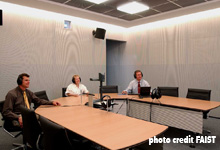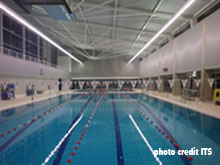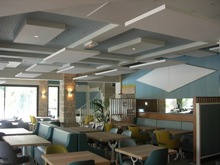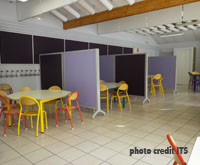Because acoustic comfort is a major criterion for the habitability of structures, ITS carries out noise measurement and study in buildings, offering diagnosis and solutions.
Noise in buildings can have different origins:
- insufficient quality of construction, in relation to a weakness in the design or to imperfections in the implementation of constructive products and systems (e.g. non-compliance with the applicable regulations in terms of acoustics, due to the failure to take it into account at the origin or due to defects)
- use of premises different from that planned or that desirable (e.g. installation of machines in premises not foreseen for this purpose, overcrowding of collective catering rooms)
- installation of noisy hardware being insufficiently soundproofed (e.g. equipment in technical rooms, Heating, Ventilation and Air Conditioning – HVAC - equipment, industrial facilities with uncontrolled sound emissions)
Noise measurement and study in buildings: diagnosis and solutions for what has to do with airborne noise insulation
What is quite often at the origin of disorders in constructions is insufficient insulation against airborne noise, e.g. when the difference in sound pressure levels between two spaces[1],[2] is insufficient to protect one of them from the other being noiser. Are then in question (possibly): floors, roofs, walls - including openings equipped with doors, windows - characterized by their sound reduction index - and also openings related to ventilation, (in the case of silencers: characterized by their insertion loss)
- the performance of construction elements (expressed in decibels - abbreviated dB -) varies with frequency, and therefore globally depends on the nature of the noise to be considered
- in practice, there can be big differences between the values of acoustic indicators measured in a laboratory and the results of on-site measurements, at the end of a project (implementation methods matter)
In this field, ITS can perform measurements in buildings to assess airborne noise insulation between adjoining spaces using a noise generator and a sound level meter[3],[4] , compare measurement results to reference values , and perform a diagnosis when there is non-compliance (in some cases, when it comes to a heterogeneous construction, the identification of the weakest elements in terms of sound insulation can be part of the scope of service), proposing solutions to improve the situation when it is not satisfactory.
Lagging (generally: on the inside) of building envelope elements or interior separations is a common means of improving noise insulation between two spaces. The choice of constructions being metallic, based on wood panels or on plasterboards depends on the context, and the determination of the technical characteristics of such works (including the choice of associated fibrous materials e.g. mineral wool or polyester - with the determination of density, thickness and other properties - and the answers to questions relating to vibro-acoustic decoupling) must be considered very seriously in the perspective of implementing an effective solution.
In some cases, the replacement of joinery - acoustical metal doorsets, acoustical glazed frames - constitutes a path for progress, possibly integrated into constructions based on modular soundproofing panels when it is a question of limiting, at the source, the noise of noisy equipment (soundproofing canopies for technical rooms and with regard to Heating, Ventilation, Air Conditioning - HVAC -, casings and enclosures for machines in production halls, staff cabins for workshops for craft or industrial sector) with ventilation silencers.
The study of solutions for improving airborne noise insulation (between premises or with respect to outside), therefore requires in-depth knowledge of construction technology, for appropriate use of the properties of different materials and construction systems, the purpose possibly being to obtain:
- sufficiently low sound levels in the rooms of a dwelling (to allow appropriate comfort), in offices (to allow tasks to be performed in good conditions)
- (as far as industry is concerned) equivalent continuous and peak sound pressure levels low enough on the one hand to prevent risks to workers' hearing and on the other hand to avoid the various inconveniences associated with working places that are too noisy (e.g. difficulty in oral communication, risk that warning signals are not heard, fatigue, stress, loss of quality, absenteeism, difficulty in recruiting)

airborne noise reduction is a fundamental aspect of acoustical comfort |
|
Noise Measurement and study in buildings: diagnosis and solutions for what has to do with the reverberation of premises
A fairly common defect for buildings is excessive reverberation when materials in sufficient quantity and quality - illustrated by their acoustic absorption coefficient (in % i.e. from 0 to 1 except when measured in a reverberation room, the Sabine factor can be higher) - are lacking.
In this field, ITS can perform measurements in buildings to evaluate the reverberation time using a noise generator and a sound level meter[3],[4] compare the results of measurements with reference values, and carry out a diagnosis when there is non-compliance, by proposing solutions to improve the situation.
Covering hard surfaces (e.g. concrete, but also glass and all painted materials - as far as all or part of the frequency spectrum is concerned -) which reflect sound waves, with materials which absorb them is the general solution to the problem posed by excessive reverberation in a room, with possibilities of implementation:
- at the physical limits of the considered space (depending on the context: carpet, suspended acoustic ceiling tiles, sound absorbing wall lining)
As far as industrial premises are concerned, more information to suspended acoustical ceiling tiles or sound absorbing lining are available.
For other premises (e.g. in the tertiary sector), more information to suspended acoustical ceiling tiles or suspended soundproofing baffle are available.
- in a location being not the physical limits of the space in question (depending on the context: noise barriers and sound absorbing screens for industrial work premises, acoustic screens for tertiary premises)
The study of solutions for limiting the reverberation of premises therefore requires in-depth knowledge in the field of materials science, the aim possibly being to obtain:
- sufficiently low ambient sound levels in spaces where this is appropriate (reverberation leading to noise amplification):
- circulations and stairwells of collective housing, hotels, hospitals, tertiary activity buildings
- offices (individual or collective)
- collective catering rooms (e.g. school canteens, university and company restaurants)
- public reception areas (e.g. administration counters, clinics, medical analysis laboratories)
- childcare establishment (nurseries, kindergartens) e.g. with regard to the atrium, activity and games rooms
- sports halls (e.g. gymnasiums, swimming pools)
- work premises
- appropriate reverberation times[5] for speech:
- classrooms, meeting rooms, training rooms, lecture halls
- appropriate reverberation times[5] for listening:
- concert halls, theatres, opera houses and other musical venues
ITS offers, with or without their installation, products and linings for sound insulation, reverberation control in public access buildings (PAB) e.g. school buildings [2], healthcare facilities [2], hotels [2], sports halls [3], institutions hosting young children.
|
|
suspended sound absorbing elements for noise reduction (restaurant)
|
Noise measurement and study in buildings: diagnosis and solutions for what has to do with spatial sound decay
Too little spatial sound decay is often a problem in different contexts:
- where discretion[6] and confidentiality[7] are advisable e.g. restaurants, open spaces
- at workstations where noise pollution emitted by machines and production lines is undesirable
In this field, ITS can perform measurements in buildings to determine the spatial sound decay rate i.e. the decrease in sound pressure level by doubling the distance to a noise source using a noise generator and a sound level meter[3],[4], compare the results of measurements with reference values, and carry out a diagnosis when there is non-compliance, by proposing solutions to improve the situation.
Implementing the solutions previously described for limiting reverberation in the premises contributes to increasing spatial sound decay, by limiting the contribution to ambient sound levels of the reverberated acoustic field (as mentioned above) ; this can be at the physical limits of the space considered and /or elsewhere (using noise barriers).
This last means of action (sometimes: complementary) consists in creating, on the path of sound waves, obstacles opposing the propagation of noise for industrial premises and/or for other work or living spaces.
|
soundproofing barriers |
References used by ITS for the noise measurement and study in buildings, for diagnostics and solutions
The reference documents used by ITS for the noise measurement and study of noise in buildings, for diagnosis and solutions depend on the context, in relation to airborne noise insulation (between premises or with respect to outside ), reverberation or spatial sound decay of interior spaces:
- regulatory texts (in the form of decrees or directives being obligations with which it is necessary to comply) relating to the limitation of noise e.g. in housing - residential buildings, in education and training institutions, in health establishments, in work premises[8],[9]
- standards and guides (providing recommendations) for different spaces: living, leisure and work (there are a large number of them e.g. [10],[11],[12] to which one can refer, not to mention documents under preparation [13])
- technical specifications based on contractual acoustic performance guarantees (e.g. between a contracting authority and a builder, between a customer and a supplier of hardware or machinery)
Such documents imposing or proposing (depending on the case) variable acoustic performance indicators depending on the context, sometimes make explicit the associated acoustic measurement protocol, failing which metrology can be considered in accordance with various measurement standards, French, European or international (there are many in particular depending on acoustic indicators under consideration e.g. [14],[15],[16]) or can be based on ad hoc specifications communicated by a customer or a third party.
Means used by ITS for noise measurement and study in buildings, for diagnosis and solutions
The human resource for the noise measurement and study in buildings, for diagnosis and solutions has the different qualifications and experience required for projects of all technical levels:
- physical measurements (with a specialization in instrumental techniques i.e. in sound metrology)
- building physics (e.g. acoustics, thermal, fluid mechanics and aeraulics, construction technologies)
- modeling of sound propagation and absorption (inside buildings or outdoors)and noise transmission
ITS acoustic measurement means for the measurement of noise and reverberation in buildings, within the framework of diagnosis and studies include: sound level meters, calibrators, noise generators.
The calculation and simulation tools used by ITS for noise measurement and study in buildings, for diagnosis and solutions include:
- software packages for measurement results processing and for calculations, for the determination of regulated or standardized indicators
- tools for simulating the performance of (often: multilayered) acoustical structures, for the selection or development of construction products and systems and for the determination of their intrinsic acoustic characteristics, e.g. sound absorption coefficient and sound reduction index (and when these are silencers: insertion loss and pressure drop, with regard to aeraulics i.e. aerodynamics)
- software for predicting the acoustic performance of all constructions:
- airborne sound insulation between adjoining spaces
- noise level in premises (including: calculations of sound propagation, determination of the effectiveness of screens and the in situ effectiveness of other soundproofing devices at specified locations according to various acoustical treatment scenarios
- reverberation time and spatial sound decay rate of enclosed spaces
The means of simulation and calculation of predictive acoustics of ITS cover all needs in terms of design and sizing of soundproofing solutions.
Noise measurement and study in buildings, diagnosis and development of solutions are services in relation to which the ITS engineering and software publishing activity is periodically assessed in accordance with the requirements of the ISO 9001 standard (relating to quality management), as well as its representation activity (ITS markets all soundproofing solutions: there is nothing better to advice in the best possible way, to base the recommendation of proven and realistic solutions, to ensure the desirable continuity between the study and realization).
Spread the word !
[1] within a given property e.g. between the rooms of a given dwelling, (in an industrial or craft establishment) between a production area and offices (including workshop cabins), (in a company or administration) between workspaces such as partitioned offices
[2] with respect to external noise e.g. the noise emissions of technical equipment of buildings and the noise pollution related to human activities such as industry, transport of all kinds
[3] before (and to make possible) the definition of noise or reverberation reduction solutions, or after their implementation, in order to verify their effectiveness
[4] e.g. according to standard NFS 31057 Acoustics - Verification of the acoustic quality of buildings, which has been cancelled, or according to other sometimes normative reference documents whose application is not mandatory
[5] time required for the sound pressure level to decrease by a ratio of 1 million to 1 after the interruption of a noise source
[6] situation obtained when an effort is required to understand the content of a conversation; then, the conversation is not a source of distraction
[7] situation obtained when even with an effort to understand a conversation, it remains not understanble
[8] Directive 2003/10/EC of the European Parliament and of the Council of February 6, 2003 on the minimum health and safety requirements regarding the exposure of workers to the risks arising from physical agents (noise)
[9] Order of 30 August 1990 issued for the application of article R. 235-11 of the labor code and relating to the reverberation control of work premises
[10] NF S31-080 Acoustics - Offices and associated areas - Acoustic performance levels and criteria by type of area
[11] NF S 31-199 Acoustics - Acoustic performance of open-plan offices
[12] NF P90-207 Sports halls - Acoustics
[13] NF S31-299 "Acoustics - Acoustic quality in bars and restaurants"
[14] NF EN ISO 10052 Acoustics - Field measurements of airborne and impact sound insulation and of service equipment sound - Survey method
[15] NF EN ISO 3382-2 Acoustics - Measurement of room acoustic parameters - Part 2: Reverberation time in ordinary rooms
[16] ISO 14257 Acoustics - Measurement and parametric description of spatial sound distribution curves in workrooms for evaluation of their acoustical performance
 sound absorbing wall lining for reverberation control in a sport facility (swimming pool)
sound absorbing wall lining for reverberation control in a sport facility (swimming pool)
